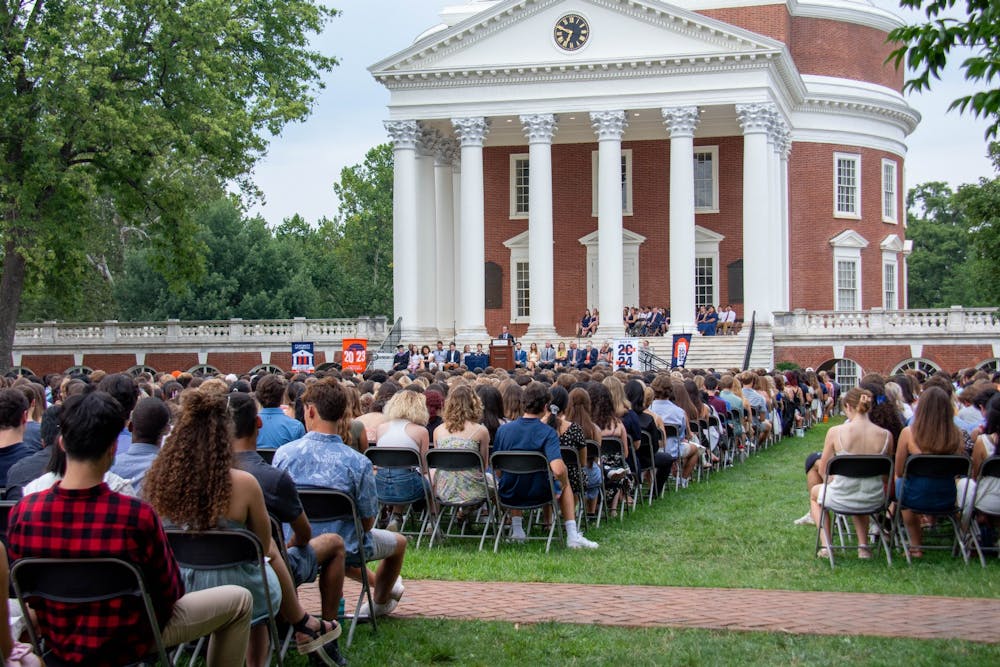Despite climbing temperatures, rain and mask mandates, the University welcomed a total of 4,648 total new residential undergraduates to Grounds last week for move-in and Wahoo Welcome programming ahead of the first week of classes. With more than 41 percent of incoming students identifying as a racial minority, the Class of 2025 is the most diverse class in University history.
Both the Class of 2024 and the Class of 2025 were introduced to University traditions at separate convocation ceremonies Sunday. Abel Liu, Student Council president and fourth-year College student, addressed both classes in a speech explaining the nature of the University’s unique student self-governance system.
“The greatest measure of love for a place is your dedication to its improvement for the improvement of the people who will come after you,” Liu said. “This theory of change, of shared self-power, and of student self-governance is a theory of love. And I hope you buy in.”
Data provided by University spokesperson Wes Hester shows that 3,918 of incoming undergraduates were first-year students, making up 84 percent of the total, while the remaining 730 undergraduates were transfer students.
The University’s target class size was 3,788, meaning that the University exceeded its goal for the first-year class by 130 students despite students having limited access to in-person tours for the second year in a row. The new student yield rate — including both transfers and first-years — was 41 percent.
In an email statement to The Cavalier Daily, Dean of Admissions Gregory Roberts said that if their past few days on Grounds have been any indication, this class of first-year and transfer students is highly enthusiastic about joining the University community.
“This class has to go down as one of the most, if not the most, resilient we have ever had the pleasure of enrolling,” Roberts said. “They have been through a lot, as we all have, and they have persevered despite significant pandemic related obstacles, at home and in their schools.”
The University received a record-breaking 48,011 applications for the Class of 2025 and offered admission to 20.6 percent of applicants through early decision, early action and regular decision application cycles.
Roberts said he was particularly struck by the number of students who expressed interest in giving back to their communities and who mentioned working a part-time job during the pandemic in their applications.
“This suggests to me that these students are compassionate and caring and they are not afraid of hard work,” Roberts said. “We are incredibly excited and grateful that they chose U.Va., and I can’t wait to see what they do in their time on Grounds.”
64 percent of the Class of 2025 is from Virginia, which is in accordance with the University’s pledge that it will maintain a two-thirds majority of Virginia residents in its student population. The incoming class represents 107 Virginia counties and cities, 320 Virginia high schools and 19 Virginia community colleges.
36 percent of new students come from out-of-state, representing a total of 49 states and territories, including Washington, D.C. Six percent of incoming students are foreign nationals, representing 91 different countries.
13 percent of new students will be the first in their family to attend college, which compares to 13.6 percent last year.
58 percent of the incoming students have at least one parent with a graduate degree, and 13 percent of students are legacies, meaning that at least one of their parents have a degree from the University.
26.3 percent of students identified as Asian or Asian American, an increase of over 9 percent from the Class of 2024, which saw 17.2 percent of students identify as Asian or Asian American. 9.1 percent identified as Black or African American, an increase from 7.1 percent for the Class of 2024. 7.2 percent identified as Hispanic, Latino, Latina or Latinx, similar to 7.1 percent who identified last year. 0.3 percent identified as Native Hawaiian or Other Pacific Islander, and 0.8 percent of incoming students self-identified as American Indian or Alaska Native.
In total, more than 41 percent of new students self-identified as a racial minority.
“The Office of Admission is committed to recruiting and enrolling students who will make a significant impact on our community, and whose lives will be transformed by their experience at U.Va.,” Roberts said. “We seek out students who are excited to share their ideas, beliefs and opinions but who are also willing to listen and connect with those who might have different beliefs than their own.”
Roberts added that the Office of Admission is developing special fall open house admission events for African American and Hispanic students, redesigning its marketing materials and planning a new summer program for 2022 that is specifically designed for underserved Virginians. In the meantime, Roberts said he is excited that the University Guide Service has been able to resume in-person tours of Grounds for those able to make the trip to Charlottesville.







